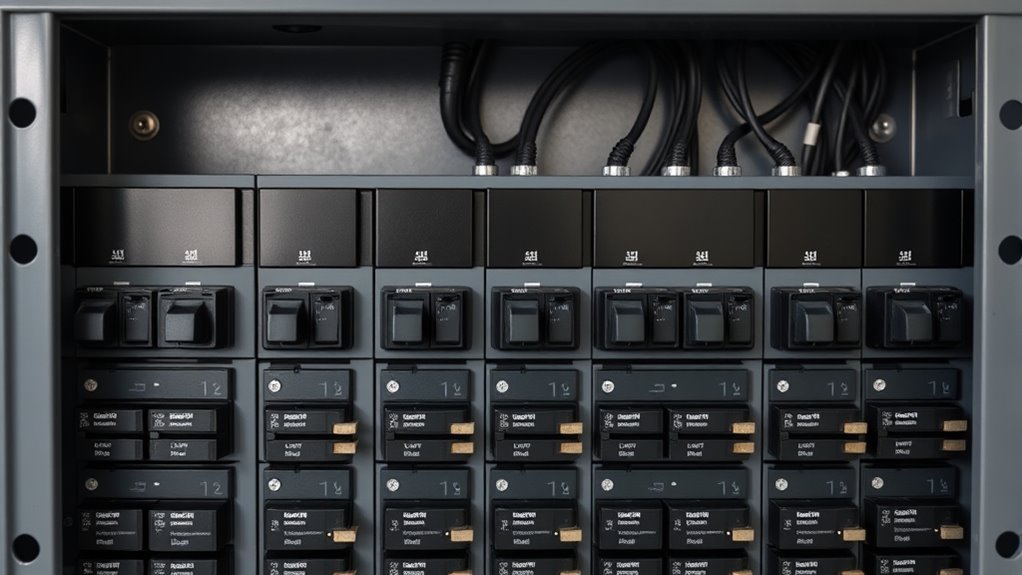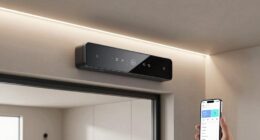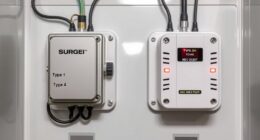A circuit breaker panel is the main hub for your home’s electrical system, distributing power safely to different circuits while protecting wiring and appliances from overloads or short circuits. It contains circuit breakers that trip when there’s a fault, preventing damage or fires. Proper grounding reduces shock risks, and clear labels help you quickly identify circuits. Keeping your panel maintained and well-labeled guarantees safety and easy troubleshooting—discover more tips to keep your system secure.
Key Takeaways
- The circuit breaker panel is the main hub that distributes and controls electrical power in a home.
- It contains breakers that protect wiring and appliances from overloads and short circuits.
- Proper grounding in the panel ensures safety by providing a safe path for electrical faults.
- Clear, updated labeling helps identify circuits quickly, facilitating maintenance and troubleshooting.
- Regular inspection and maintenance of the panel ensure ongoing safety and system reliability.

A circuit breaker panel is the central hub for your home’s electrical system, designed to protect your wiring and appliances from overloads and short circuits. It’s fundamental to understand how it works, especially when it comes to grounding safety and panel labeling. Proper grounding safety ensures that in the event of a fault, electrical current has a safe path to the ground, reducing the risk of shock or fire. Your panel should have a grounding bus bar connected to a grounding rod or metal underground water pipe. If this isn’t properly done, your entire electrical system could be unsafe, increasing the danger to you and your family. Always verify that your panel’s grounding system is intact and up to code. If you’re unsure, consulting a licensed electrician is your best move.
A well-grounded electrical panel is essential for safety and code compliance.
Panel labeling plays a key role in electrical safety and convenience. A well-labeled panel helps you quickly identify which circuit controls specific areas or appliances in your home. For example, if you need to reset a tripped breaker in the kitchen, clear labels let you find the right breaker swiftly, preventing unnecessary guesswork or accidental shut-offs. Proper labels also make troubleshooting easier and safer. If an appliance causes a breaker to trip repeatedly, knowing exactly which circuit it’s on allows you to address the problem efficiently. When installing or inspecting your panel, take the time to label each circuit clearly and accurately. Keep labels legible and up-to-date, especially if you add new circuits or make changes to your wiring. This simple step can save you time and prevent errors during emergencies or routine maintenance. Regular inspections and updates can also help identify issues with grounding safety, such as corrosion or loose connections, which could compromise your system’s safety.
It’s equally important to guarantee your grounding safety is maintained over time. Regular inspections can reveal loose connections or corrosion that might compromise the grounding system. A faulty ground can mean the difference between a safe shutdown and dangerous electrical shocks. Always turn off the main power before inspecting or working on your panel. If you notice any signs of deterioration—corrosion, loose wires, or damaged components—call a professional to repair or upgrade your grounding system. Remember, grounding safety isn’t just about compliance; it’s about protecting your home and loved ones from electrical hazards.
Lastly, keep your panel’s labeling organized and clear. Use durable labels resistant to heat and moisture, and update them whenever circuits change. This proactive approach ensures your electrical system remains safe, understandable, and easy to work with. By paying attention to grounding safety and panel labeling, you’re taking essential steps to keep your electrical system reliable and secure. Proper maintenance and awareness of these aspects help prevent accidents and make future repairs or upgrades smoother. Your circuit breaker panel is a fundamental component; treat it with care, and it will serve your home safely for years to come.
Frequently Asked Questions
How Often Should I Have My Circuit Breaker Panel Inspected?
You should have your circuit breaker panel inspected at least every 3 to 5 years to guarantee breaker safety and proper panel maintenance. Regular inspections help identify potential issues like worn breakers or loose connections before they cause problems. If your home experiences frequent power outages or you notice flickering lights, it’s wise to schedule an inspection sooner. Staying proactive keeps your electrical system safe and reliable.
Can I Upgrade My Panel Myself or Need a Professional?
You shouldn’t attempt DIY upgrades to your panel; over 60% of electrical accidents involve improper handling. Upgrading your panel requires professional skills because panel compatibility and safety standards are complex. A licensed electrician ensures proper installation, adheres to codes, and guarantees your safety. While it might seem straightforward, an expert’s touch prevents costly mistakes and potential hazards, so always hire a professional for panel upgrades.
What Are Signs My Circuit Breaker Panel Needs Replacement?
If your circuit breaker panel shows signs like frequent tripping, burning smells, or scorch marks, it’s time for a replacement. Cracked or damaged panels and outdated models also compromise electrical safety and indicate the end of their panel lifespan. Ignoring these signs can lead to electrical hazards. You should have a professional assess your panel to guarantee safety and proper functioning, preventing potential fire risks or damage.
Are There Different Types of Circuit Breakers for Specific Appliances?
Yes, there are different types of circuit breakers designed for specific appliances. You might need appliance-specific breakers or dedicated circuit panels for high-power devices like dryers, ovens, or HVAC systems. These breakers guarantee safety and proper function by providing the right level of protection. Using the correct breakers prevents overloads and damage, so always check your appliance requirements and consult an electrician if you’re unsure about the right setup.
How Do I Reset a Tripped Breaker Safely?
To reset a tripped breaker safely, first turn off any affected appliances. Then, follow the reset procedures: switch the breaker fully to the OFF position, wait a few seconds, and then flip it back to ON. Always observe safety precautions by wearing insulated gloves and keeping your hands dry. If the breaker trips again, avoid re-resetting and contact a professional electrician to inspect the issue.
Conclusion
Now that you’ve revealed the secrets of your circuit breaker panel, you’re the captain steering your home’s electrical ship. Think of it as a sturdy fortress guarding your daily comfort, ready to spring into action at the first sign of trouble. With this knowledge, you hold the power to keep things running smoothly and safely. Remember, a well-understood panel is your home’s heart—strong, reliable, and always ready to protect what matters most.









